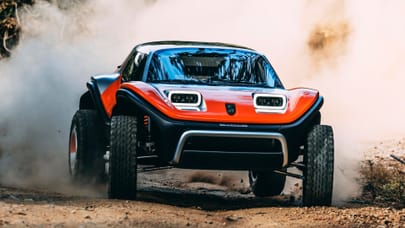
Clarkson on: the Jaguar XJ220
One hour ago, I was nudging 200mph on a desert highway in a Jaguar XJ220. It felt good, but it was not quite as good as the view in my rear view mirror, because behind me was a Porsche 959 and a Ferrari F40. And in front was an F50.
We weren't exactly racing but it was impossible to come out of a roundabout without mashing the Jag's heavy duty throttle into its equally heavy duty carpet and feeling those turbos start to sing their alto tunes.
It was the first time I'd driven the big Brit bruiser and though it was ponderous compared to the Italian duo, it was a lot better than I thought it would be. However, despite giving the fat cat some serious stick, I was left feeling a bit empty. Here I was in one of the most exciting cars ever made, and I was bored. You see, I've now driven the ultimate machine, a world championship winner which is hurled along by 1,800 horsepower.
I'm talking about a powerboat - the Victory Team's all-conquering Class One 43-footer with its brace of big block Chevy units, tuned to rip the ocean apart with 1,500ft lbs of torque. There are only two seats. On the left was Saeed Al Tayer, who would operate the throttles and the four gears. I was in the right pod, with the wheel. The cockpit glass is taken from an American F-16 fighter and the dash has all the hallmarks of a jet too, but there's a steering wheel, a racing seat and a five-point harness, so it feels kind of like a car too.
The points of the twin hulls stretched into the middle distance, obliterating the view. This was a problem because Saeed had just fired up the £600,000 beast and it was my job to get it out of the marina.
"You must be pretty nervous," I said over the intercom as we headed into the open sea. "Oh no," came the reply. "I've never done the throttleman's job before." With that, he pushed them all the way to the stops.
"The gearchanges are ponderously slow, but the GPS speedometer’s relentless churning defied belief"
The gearchanges are ponderously slow, but the GPS speedometer's relentless churning defied belief. Thirty seconds from the line and we were doing 100mph. Then we went past 120, 125 and 130. At 132mph, you could hear us in Barnstaple but that was all the small propellers would give. With the big racers on, they've had this baby up to 144mph. 132 feels fast enough though, especially when you look out of the side of the canopy at the water just four feet below. It has a solid, concretey sort of appearance. I was mesmerised and didn't hear the rescue helicopter's pilot begging us to slow down. Seems his Jetranger couldn't keep up.
Now, so far we'd been on a flat sea, going in a straight line, but with Iranian waters ahead, Saeed asked me to make a wide right turn. And that was like nothing I have ever felt. Damon Hill tried this boat and said it was like a 300mph fork lift truck but that's cobblers because the response was immediate - one twitch of the wheel and those twin points were turning, with no roll. And I could feel, even though Victory weighs four tons, the hull on my side gripping the water. This was like a racing car. "Yes," said Saeed, "and it will spin like a racing car too, so not so much lock next time."
The deck of the boat is essentially an aeroplane wing, designed to hoist the hulls out of the water and reduce friction. So, as we cruised past the ton once again only the bottom third of the props were in the water. Everything else was airborne. This makes the ride almost Jaguaresque but it's not always so. A modern day powerboat is expected to race through 40 knot winds in six-foot seas if need be, and they must be able to average 100mph in the process.
Top Gear
Newsletter
Thank you for subscribing to our newsletter. Look out for your regular round-up of news, reviews and offers in your inbox.
Get all the latest news, reviews and exclusives, direct to your inbox.
If you've never seen this spectacle, I urge you to catch a race one day soon. The boats skip from wave to wave, with the throttleman desperately trying to make sure he has full power when he's in the sea, and not much when he's twelve feet above it. To land with props spinning at Mach Two would rip the shafts apart.
Race tracks are designed to aid the passage of racing cars, but the sea is designed to create weather, and as a home for sharks. If you get it wrong in a race car, Murray Walker will have something to talk about. But if you get it wrong in a Class One boat, you will only need a coffin big enough for your ear, toe or whatever tiny bit they happen to find. It is the ultimate thrill.
Trending this week
- Car Review
BMW 1 Series
- Top Gear's Top 9
Nine dreadful bits of 'homeware' made by carmakers








